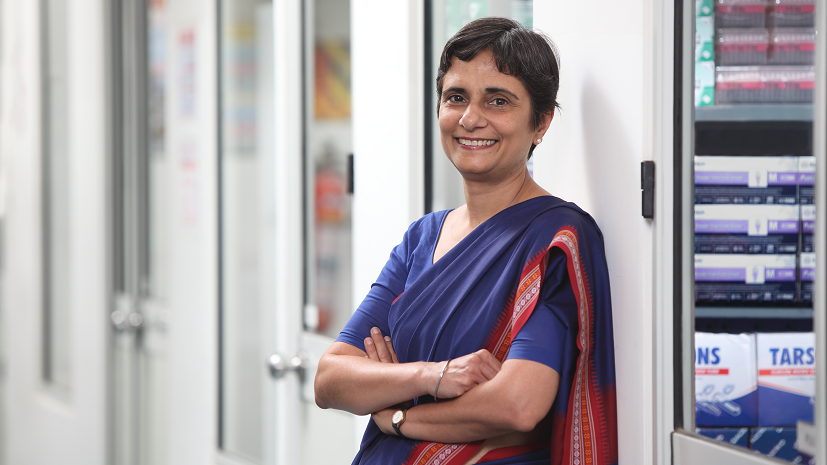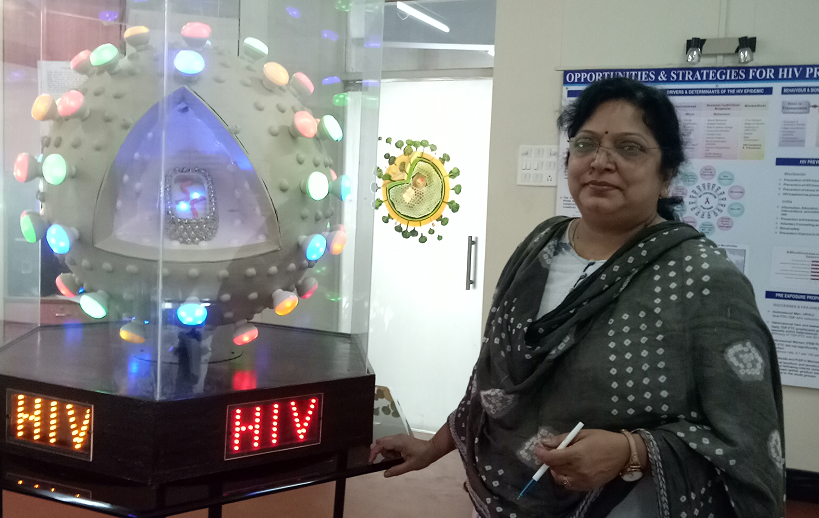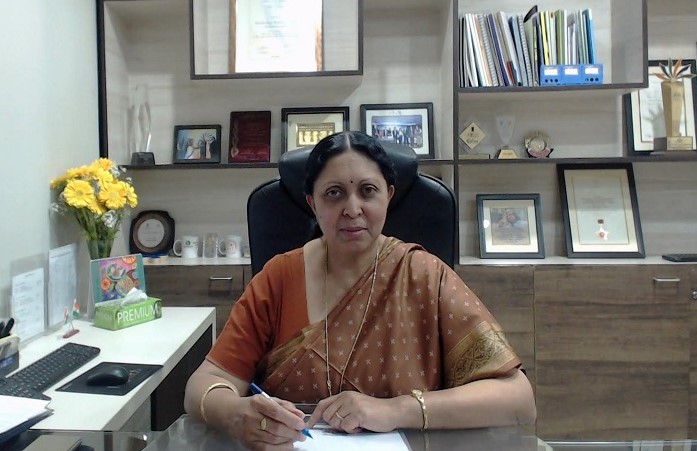
Dr Gagandeep Kang Photo credit: Infosys Science Foundation
There has always been a gender gap as far as women in science are concerned. But there are many women in India who have been closing the gap, taking up some of the most important research projects in fields as diverse as community medicine, medical anthropology, molecular biology, socio-behavioral science, etc. But most of them continue to be unsung heroes. As we get ready to celebrate International Women’s Day, Healthpost speaks to three women scientists who have made commendable contribution to healthcare in India.
Dr Gagandeep Kang
Her father was an officer in Indian railways. On his postings in small towns where there were not many means of recreation, he would set up science experiments every Sunday and ask young Dr Gagandeep Kang and her elder sister to solve them. And both would spend the whole day solving the mystery. No wonder then as she grew up, she got deeply interested in science, especially in medicine.
After completing her medical studies in 1991, she wanted to find answers to larger issues concerning human health. So, within a few years of practicing as a physician, she started research in infectious disease at Christian Medical College, Vellor. “I wanted to do something that can improve health of thousands of people. I had to work with both clinicians and communities,” says Kang, executive director, Translational Health Science and Technology Institute (THSTI).
In community medicine, Kang chose what she felt was the most challenging-- gut infections. The gut has unusual flora, it is home to a few kilograms of bacteria, mostly friendly bacteria that help in digestion and absorption of food. But it can also become a reservoir of disease causing bacteria -- bacteria that can cause severe diarrhea, dysentery, typhoid, and many other infections.
Interestingly, some of these bacteria are medicine in themselves and others may help in developing drugs against infections. “By studying the behavior of these bacteria , we can curb some chronic infections. It has been 30 years now, I am still to solve their mystery.”
Dr Kang has worked extensively on rotavirus vaccine, which provides protection against severe rotavirus infection, a leading cause of diarrhea in young children. The vaccine is expected to bring down the incidence of diarrhea by 15-37 per cent. Last year the vaccine was launched under Universal Immunisation Programme in four states.
She is currently busy studying the impact of the vaccine in these four states so that the government can expand the vaccine programme. “We have to ensure that adequate number of children in the targeted age – group receives the vaccine. If there is a reduction in the incidence of diarrhea in the state, we get to know the impact of the vaccine. It is a long and arduous process of collecting data, building elaborate algorithms and analyzing it. We are hoping to complete it by the end of this year,” she says.
Kang feels that though the vaccine is the most cost-effective method to prevent a disease, there is an urgent need to speed up the process of providing safe drinking water, sanitation, hygiene, and nutrition to people living in urban slums and in rural areas.
These interventions, she says, have a long-term impact on the health of a community. She gives an example of the communities in Vellore she has been working with for 20 years now. One of them is a slum with a population of over 45,000, where she has been working for the past 20 years, and then there is another slum with a population of 60,000 where she has worked for the last 10 years.
“The government built infrastructure-- helped these people with pucca houses. It built bathing facilities and improved the drainage system in the area. We educated people about the importance of right nutrition. And we see that over a period of time the nutritional status of the people improved and the incidence of gut infections went down,” she says. “I believe even small changes can bring big results. Adding one egg a day to midday meal of children has the potential to improve their health significantly.”
Gut infections spread in a community if proper hygiene is not maintained. These are a leading cause of malnutrition in India. Another major concern is antibiotic resistance. She gives example of Typhoid, an enteric infection. It spreads through contaminated food and water. Sometimes, Salmonella typhie, the bacteria that causes typhoid hides itself in the gall bladder of a patient. The patient then becomes a carrier of the disease and spreads it to others.
“Typhoid was a big killer in the 1930s and 40s. Later with antibiotics, we could treat it effectively but soon bacteria developed resistance to all the potent antibiotics against it. Today, we are running out of options,” says Kang.
What we require, says Kang, is a deeper understanding of molecular biology and various environmental, behavioural and social factors associated with a disease. By combining them, we can prevent, manage, control and treat a disease better. “Now we have a typhoid vaccine and by locating places with high incidence of typhoid, we can effectively control the disease with the help of the vaccine,” she says.
The biggest challenge before Indian scientists, Kang says, is lack of adequate funds for their research. “It took 25 years to develop rotavirus vaccine. It required huge investment. But unfortunately, India is not liberal when it comes to spending on research and development.”
Secondly, young scientists don’t get good mentors. Most scientists remain busy with their own research throughout and it is not mandatory for them to mentor and guide their younger colleagues, the only way to multiply the good research.
 Dr Seema Sahay
Dr Seema Sahay
Dr Seema Sahay
As a child Dr Seema Sahay wanted to become a scientist—though all she knew about scientists was that they worked in lab, spent the day on microscope learning intricacies of human biology.
So, her happiness knew no bounds when her dream came true and, in 1986, she walked into a lab for the first time to initiate her research in cytogenetics.
But science, she says, revealed its true meaning to her in the late 90s, when she got an opportunity to be part of Social and Behavioural Science division of National AIDS Research Institute, ( NARI) Pune, where she worked with HIV- positive patients.
“I realized that the whole world is a research laboratory where human experiments are going on. We needed to analyze them for our own benefit. I was thrilled to be a part of this experiment,” she says.
Her stint at NARI , she says, helped her acquire a deeper understanding of human behavior and community norms. “It is important for any scientific discovery to reach and benefit people, so I needed to learn socio-behavioural science. Any vaccine or medical product is useless if it is not accepted and used by people,” she says.
At NARI, Sahay led a team which designed community- based programmes to initiate phase-1 HIV vaccine trials and clinical trials for microbicides to prevent HIV infection from spreading within the community.
“I thought not many people would be interested in participating in clinical trials, but was amazed that we got more volunteers than we needed. Among them were people who had lost someone in their families to HIV infection and those who were looking for prevention. And then there were some who simply wanted to be a part of a major science discovery. I saw a completely different aspect of human behavior during the trials,” she says.
“It was a huge responsibility to make people understand the nuances of participating in clinical trials, the pros and cons, the possible long-term repercussions. In phase-1 vaccine trial, all volunteers were healthy and at low-risk of getting the disease. I wanted them to take an informed decision.”
Sahay says that a deeper insight into science is the only way humans can survive deadly diseases. But at the same time, everyone needs to understand that scientific experiments involve living beings. As a medicine goes into a human body, there could be many known and unknown consequences. “People tend to think that if a product is coming from a big institute, it would be safe and protect them against HIV. So, it is necessary to clearly make them understand the experimental status of the product,” she says.
The project brought Sahay closer to communities in which HIV prevalence was high, and it encouraged her to learn more about mental health issues and psycho-socio needs of her patients. “In the 1990s, we didn’t have any medicine to offer to patients suffering from HIV infection. It was almost impossible to manage a life-threatening infection without effective medicine. But at the same time, our responsibility was to prevent it from spreading to the large communities.
The biggest challenge was to make patients tell their partners about their disease as they were at the immediate risk of contracting it,” she says. “It is still a challenge.”
But thankfully, much has changed for better. Sahay feels empowered as she has many effective medicines to offer to her patients. Most of her patients on anti-retro viral therapy lead a normal life. And nothing makes her happier than that.
 Dr Renu Swarup
Dr Renu Swarup
Dr Renu Swarup
“Innovations are the only way to change the destiny of a developing country,” says Dr Renu Swarup, managing director, Biotechnology Industry Research Assistance Council (BIRAC), a central government non- profit enterprise that works to promote research and innovation in the field of biotechnology.
Swarup was a researcher in plants genetics when she switched roles from an active researcher to a science manager. As a science manager, she has worked in different fields of science-- bio diversity, energy conservations, plants genetics.
“The challenge is to ignite the young minds and encourage them to take up new innovative scientific projects. I feel that there is a greater need to strengthen bio-technology, which contributes majorly to health, energy, agriculture sectors.”
Swarup feels that India needs to come up with affordable innovations by Indian scientists. “The products should be sophisticated, cost-effective and of high-quality that can be introduced in a global market,” she says.
She is happy that almost 60 per cent of the innovations that scientists at BIRAC have come up are related to health. Half of these innovations are point-of-care devices for infectious diseases, medical implants, neonatal monitoring device that have potential to revolutionize the primary healthcare in rural as well as urban areas.
“Imagine an earphone-like ECG monitors, a compact and easy-to-use dengue detection kit, or a device which can tell you about 10 body parameters with a prick of blood. Such products when combined with telemedicine can revolutionize healthcare. They can connect a patient in the remotest area with a doctor at a state-of-the-art medical facility in the city. They can help government collect data on various health issues, which can be used for better planning,” she says. “Around 50 such products have reached the commercial level.”
Talking about another, one-of-its-kind research projects, Dr Swarup says, “Our scientists are trying to develop drugs from microbs. We have collected 200, 000 microbial cultures and got 100 potential drug candidates, and 50 new drug molecules,” she says. “And mind you it is just the beginning.”